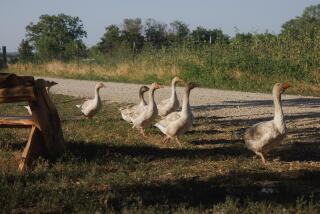No-Till Approach Makes Groundbreaking Method of Soil Conservation
- Share via
LEXINGTON, Ill. — Jim Kinsella turns a spadeful of black soil on his 640-acre corn and soybean farm, exposing a pack of wriggling earthworms that signal an abundance of organic material.
The soil breaks apart easily in his hands and suffers far less from erosion caused by wind and water. Pheasants and other wildlife flit about in the crackling cornstalks left scattered on the land after harvest.
Kinsella’s land is twice as rich in nutrients as it was when he first abandoned deep plowing 21 years ago.
“Farmers are still infatuated with tilling, but they are kind of living in the past,” Kinsella said. “The soil plays out. You can only do that for so long.”
Across America, an increasing number of farmers are turning to no-till methods to stop loss of topsoil and improve its organic content, conserve ground moisture, and reduce runoff of pesticides and fertilizer into lakes, streams and rivers.
“Tillage is a disaster for the soil. It’s like a hurricane coming through,” said Steve Groff, who runs a no-till 135-acre vegetable farm in Lancaster County, Pa. “I’m going to leave this soil in better condition than when I found it.”
In simple terms, no-till means just what it says: not plowing the ground, or at least disturbing the topsoil only minimally, to plant seeds. Crop residue is left on the field over the winter to improve soil quality and stop erosion, and crops are rotated each year to cut down on diseases and insect infestations that take root if the same crop is planted year after year.
To be sure, thousands of farmers still crank up their tractors and plow the land just as their fathers and grandfathers did.
Kinsella said those traditional methods are somewhat easier and do promote faster early growth in crops, because the soil warms up faster and the nutrients are exposed. Beyond that, he said, many farmers view no-till as a fad with unproven economic consequences.
“Farmers are very traditional, and they’re very slow to change,” he said. “There is a stigma to no-till.”
But there are some economic benefits to the methods.
Because farmers don’t repeatedly go into the fields to plow, on a typical 500-acre farm they can save up to 3.5 gallons of fuel an acre, $5 an acre on machinery wear and maintenance costs, and four 60-hour workweeks in labor time, according to the Conservation Technology Information Center. The center, based in West Lafayette, Ind., is a government-agribusiness partnership that promotes no-till methods.
Conservation Technology’s latest statistics show that three common conservation tillage systems accounted for almost 110 million acres of farmland in 1997--or about 37% of the total acres planted. Conventional deep plowing with metal disks and blades was practiced on about 107 million acres, while reduced-till farming accounted for another 77 million acres.
Although the methods have been in use since the 1960s, there is more interest than ever now that the 1996 “Freedom to Farm” law is phasing out subsidy payments and ending restrictions on what farmers can plant.
This is especially true in the Great Plains, where many farmers once planted only wheat and let the land lie fallow the next season. Now they need more income from the land and are looking for new crops to put into a rotation, such as sorghum and sunflowers. Many view no-till as a way to save money and conserve precious soil moisture in the dry climate.
“The West is really going to be the area of growth in the next five years,” said Dan Towery, an Agriculture Department conservation official who works at CTIC. “A wheat-fallow rotation just isn’t economically viable anymore.”
There are new challenges with no-till methods. There is more variability within a single field, meaning farmers must use precise amounts of fertilizer and improved seeds to have desirable yields.
New equipment must be purchased and techniques learned, such as leaving mounded strips of soil on fields over the winter to warm the soil when planting time comes.
“When you first start doing this, you might suffer a yield hit,” Groff said. “The soil has been addicted to tillage.”
But this season, Kinsella said his yields were above average in his north-central Illinois county.
“It takes better management to make it work. It takes patience,” he said.
In the big picture, Kinsella said reduced deep plowing could cut the release of carbon dioxide from the soil to the air, helping ease global warming. And the increased carbon dioxide in the soil will help farmers grow enough food to feed the expanding world population without using more and more chemicals and fertilizers.
“People are starting to recognize there are limits to what we can do to the soil,” he said.






